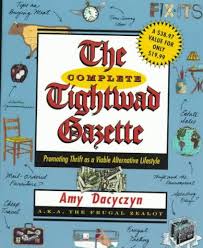Frugality and the Environment
It’s no coincidence that most frugal people are environmentally conscious, and vice versa. Frugal lifestyle choices tend to be environmentally friendly choices. It’s almost impossible to be concerned about the environment without taking actions that lessen your own environmental impact. Similarly, it’s difficult to be frugal and still have a large negative effect on the environment. The two lifestyles are connected in such a way that dedicating yourself to one or the other almost guarantees commitment to the other, whether you fully realize it or not.
True frugality is not just about saving money, although that’s often the most noticeable benefit and the reason people initially “turn frugal.” True frugality is about using fewer resources, getting more use out of existing goods, and throwing away less over a lifetime.
Sound familiar? Those ideas are also at the heart of environmental consciousness. Understanding the connection between the two movements and making some lifestyle changes that reflect that understanding will result in a healthier financial picture for you and a healthier future for the earth.
So how easy is it to improve the environment and your bottom line simultaneously?
Here are ten frugal changes you can make that also benefit the environment.
1. Use homemade cleansers rather than commercial preparations
Commercial cleansers are overpriced, over packaged, and full of harsh chemicals. There are very few cleaning projects that baking soda, vinegar, and water cannot handle. These ingredients are inexpensive and easy on the environment. Recipes are widely available online and in books about frugality.
2. Switch to cloth whenever possible
Reusable cloth napkins, diapers, and cleaning rags are all kinder to the environment than disposable. Cloth creates less waste and requires fewer resources to manufacture than disposable or paper products. Cloth items are also less expensive over the life of the item than their disposable counterparts. Take reusable cloth bags to the store. You’ll prevent plastic bags from entering the landfills and, if your store offers rebates for using cloth and/or charges for plastic as many are beginning to do, you’ll save money.
3. Buy used whenever possible
Buying used from yard sales, thrift shops, and consignment stores means that no additional resources went into making your item, and you’ve prevented the used item from ending up in a landfill prematurely. Used items are generally much less expensive than new, saving you money. Want to take this one step further? Borrow or rent items rather than buying when possible. Organize a neighborhood tool or craft supply swap, visit your local library and borrow books, or rent movies and games rather than buying. You’re helping the environment by using existing items, and you’re saving yourself even more money by not buying.
4. Use Mother Nature’s free utilities
If you’re allowed to have a clothesline, get one and use it. Let the sun dry your clothes for free. Even if you can’t have a clothesline, indoor drying racks work just as well. Use nature to your advantage in other ways. Open your windows for air rather than cranking up the AC. In the winter, open your blinds to get some free heat. Collect rainwater and use it for watering your garden and flowers. You’ll be using fewer resources and lowering your utility bills in the process.
5. Take up gardening, but don’t use commercial pesticides
Growing some of your own food will save you money and result in healthier, less processed food. You’ll save even more money by composting for fertilizer and using natural pest control techniques, such as introducing repelling insects and plants into your garden. These methods are both frugal (almost free, even) and environmentally friendly.
6. Consume fewer resources
There are many ways to conserve electricity, water, natural gas, and gasoline. Simply turning off unused lights and checking for leaky faucets are good places to start with electricity and water. Driving the speed limit and maintaining your car are simple ways to save fuel. Check online, in books about frugality, and with your utility for more conservation ideas. Each idea you implement not only conserves more resources, but saves you more money as well.
7. Learn to cook from scratch
You’ll eat healthier without all the preservatives, and homemade foods are much less expensive than processed foods. And think of all the packaging you’ll keep out of the landfills if you cut down your use of over packaged, individually wrapped foods.
These last three ideas derive from a slogan used to motivate the home front during World War II: “Use it up, Wear it Out, Make it do.” It was sound advice then and remains so today.
8. “Use it up”
Use everything you buy and waste nothing. Don’t buy more food than you can eat before it goes bad and don’t throw away leftovers. Get every bit you can out of bottles and tubes of shampoo, moisturizer, etc. Find second lives for products and packaging such as using jars or cans for storage, using magazines for craft projects, reusing boxes for gift wrapping or storage, using bread bags for carrying lunches to work, or using old clothes for rags or craft material. Get creative and come up with your own ideas. Using things up not only ensures that you get every penny from your purchases, it also limits the amount of waste entering the trash stream.
9. “Wear it out”
Drive your car until it dies. Wear your clothes and shoes until they wear out. Use your lawnmower until it begs to be taken to the landfill. Avoid upgrading your electronics and computers until they either break or become so obsolete that they no longer perform the functions you need (need, not want). Wearing it out means that you don’t throw things away just for the sake of wanting something newer, flashier, or “cooler.” You only replace when an item is truly worn out beyond repair, becomes unsafe, or prevents you from getting the job done.
10. “Make it do”
Tons of stuff ends up in landfills that only needs minor repair work to be serviceable again. Take the time to mend your clothes, refinish your furniture, or repair your lawnmower. Learning basic home, car, and appliance maintenance/repair techniques will keep you from having to shell out big bucks every time something breaks, and your knowledge will keep salvageable items out of landfills.

You don’t have to give up all your conveniences and go back to frontier-style living to make a big difference to both your wallet and the environment. The more willing you are to learn and experiment, the greater your potential savings and environmental conservation.
There are plenty of places to find ideas, but one of my favorites for those new to frugality is The Tightwad Gazette by Amy Dacyczyn. Just remember that even small changes will make a difference. After a while, you just might find yourself eager to do more as you acquire more skills (and start seeing those savings accumulate in your account).
~ By Jennifer Derrick, originally entitled
"10 Frugal Moves That Improve the Environment"

Posted by Lexi with Love



4 comments:
Another great post. Loved this one!
I use to be a 'shopaholic', it's been a long tough road to achieve 'frugal-ism'.....and I still struggle for the urge to buy -however- I am slowly getting there. It's an adventure and I am enjoying the journey!
Thank you so much for your comment!
Shalom,
Patty
very useful read. I would love to follow you on twitter. By the way, did any one learn that some chinese hacker had busted twitter yesterday again.
At me a similar situation. Let's discuss.
Post a Comment